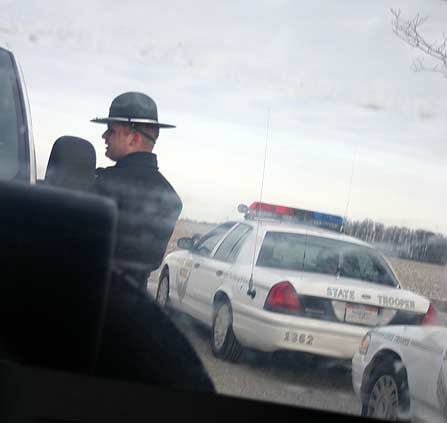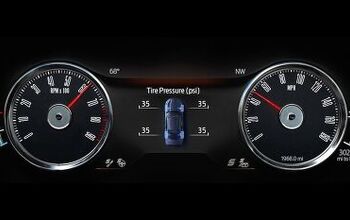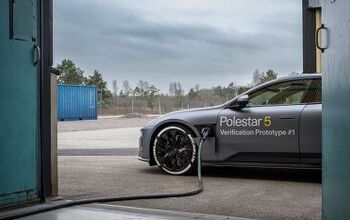Ohio Supreme Court Upholds Speeding Ticket By Visual Guess
In a 5-1 decision yesterday, Ohio’s Supreme Court upheld a speeding ticket based solely on how fast a driver appeared to be moving. The court considered the case of motorist Mark Jenney who drove through a State Route 21 radar speed trap operated by Copley police officer Christopher R Santimarino on July 3, 2008. Santimarino guessed based on the appearance of Jenney’s black SUV that it was traveling at 79 MPH in a 60 zone.
Santimarino claimed that his thirteen years as a traffic cop and his certification in speed estimation by the Ohio Peace Officer Training Academy qualified him to make expert visual determinations of how fast vehicles are moving within 4 MPH. In court, Santimarino testified that his radar showed Jenney was traveling at 82 MPH on direct examination and 83 MPH on cross-examination.
Based on this, a district court convicted Jenney. On appeal, Jenney succeeded in having the radar evidence thrown out because the officer failed to produce the required certification documents at trial. The appeals court then ruled that the visual guess as to Jenney’s speed was sufficient evidence for a conviction. Jenney appealed to the supreme court, which agreed with the lower court rulings that an officer’s educated guess is sufficient to overcome that state’s burden of proof beyond a reasonable doubt.
“A majority of the appellate districts that have considered the issue have held that an officer’s testimony that in his opinion, a defendant was traveling in excess of the speed limit is sufficient to sustain a conviction for speeding,” Justice Maureen O’Connor wrote for the majority. “Given Santimarino’s training, OPOTA certification, and experience in visually estimating vehicle speed, his estimation that Jenney was traveling 70 miles per hour was sufficient to support Jenney’s conviction… We hold that a police officer’s unaided visual estimation of a vehicle’s speed is sufficient evidence to support a conviction for speeding in violation of R.C. 4511.21(D) without independent verification of the vehicle’s speed if the officer is trained, is certified by the Ohio Peace Officer Training Academy or a similar organization that develops and implements training programs to meet the needs of law enforcement professionals and the communities they serve, and is experienced in visually estimating vehicle speed.”
Justice Terrence O’Donnell filed a dissent that argued the majority essentially created a standard that the police officer is always right.
“Like any other witness, a police officer’s credibility is to be determined by the jury or other fact-finder,” O’Donnell wrote. “In fact, jury instructions given regularly by trial judges advise that a jury is privileged to believe all, part, or none of the testimony of any witness. Thus, I would assert that a broad standard as postulated by the majority that a trained, certified, and experienced officer’s estimate of speed is sufficient evidence to support a conviction for speeding eclipses the role of the fact-finder to reject such testimony and thus such testimony, if found not to be credible, could, in some instances, be insufficient to support a conviction.”
A copy of the decision is available in a 50k PDF file at the source link below.
Barberton v. Jenney (Supreme Court, State of Ohio, 6/3/2010)
[Courtesy: Thenewspaper.com]
More by The Newspaper
Latest Car Reviews
Read moreLatest Product Reviews
Read moreRecent Comments
- Dave M. My hipster daughter is greatly into it. We watched the race together this weekend. It was interesting but I'm not devoted to it like she is. She'll be at the Austin race in October.
- Bd2 If I had time to watch other people driving, then I would go for LMP.
- Steve Biro There are 24 races on this year’s F1 schedule. And I guarantee you no more than two will be reasonably exciting, Meanwhile, F1’s reception for Andretti reveals the dark underbelly of the sport. I have followed F1 since the 1960s and, frankly, I am running out of interest. I’ll catch a race if it’s convenient but won’t bother DVRing them.
- YellowDuck Been watching since the 80s, seriously since the 90s once we had reliable TV coverage. I'm in Canada though. Hey, and don't forget that the Interlagos race is also in a convenient time zone, as is Mexico. So that's 5 races in the Americas. Absolutely love it, but it takes a bit more interest in the technical / strategic side of things to really appreciate it. It's not just going fast in circles until someone crashes into someone else, while drunk people watch. The US can be proud of what it has contributed - Austin is one of the best tracks on the calendar, Vegas turned out to be much better than anyone could have hoped, and even Miami - a real Indy car-style track - produced a good race this year.
- JMII I watch every F1 race, same with Indycar which is 100X better in terms of actual racing.


































Comments
Join the conversation
This is nothing new, cops have been estimating speed for years. On the other hand, the radar had him at 82, and +20 over could get you a reckless driving ticket in some states.
Aren't conservatives the ones railing against activist judges who legislate from the bench instead of interpret existing law? I haven't read the opinion, but it seems to me that the Supreme Court was asked to opine whether visual speed estimation is legal under Ohio law. Their answer was yes. No cause for alarm here, a question was asked and the Ohio Supreme Court answered it. It is perfectly acceptable for the legislature to change the law, now that the Supreme Court made its determination. That's the way the system is supposed to work, isn't it?